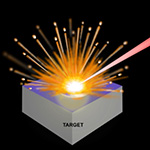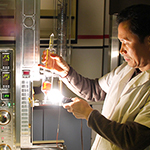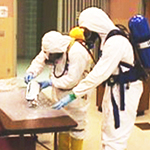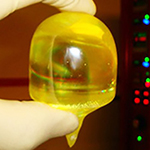BTC Contract Awards
Following are BTC contract awards beginning with the most recent in 2020. To discuss, please contact Sudhir Trivedi (technical) or David Chaffee (applications and markets) at 410-472-2600.
2020
BTC received follow-on Funding from NASA related to an earlier contract award “Dual Channel Acousto-Optic Tunable Filter Spectrometers.”
We received a Phase I SBIR from the U.S. Army titled “Remote Laser Induced Breakdown Spectroscopy (LIBS) and Laser Induced Thermal (Infrared) Emission (LITE) Detection System for In-situ Surface Contaminant Mapping and Identification.”
BTC was awarded a Phase I SBIR from NIH for “New Photo-Acoustic Imaging Process in Fetal Monitoring to Dramatically Reduce Brain Injuries in Newborns.”
We received a Phase I SBIR from the Missile Defense Agency related to “Bi-Modal Technology for In-Situ Defect Detection in Additively Manufactured Parts.”
The Defense Logistics Agency awarded BTC a Phase I award having to do with “Rapid Viral Pandemic Suppression with Molecular Affinity Development.”
We were awarded a Phase I SBIR from the U.S. Navy related to “Compact Spectral Imager in Integrated Dewar Assembly.”
BTC received a subcontract from UES for Crystal Growth of the Band Gap Engineered II-VI Ternary Compound.
UES also awarded BTC a Consultant Agreement related to “Liquid Crystal Support for Aircrew Eye Protection.”
2019
BTC received a subcontract rom EPIR as part of a U.S. Army Phase II award. The topic was “Multi-Spectral Threat Warning Adjunct Sensor.”
We received a Phase III award as part of an STTR from NASA to supply “Dual Channel Acousto-Optic Tunable Filter Spectrometers.”
BTC received follow-on funding from the U.S. Army related to “AOTF-Based Spectro Polarimetric Imaging System for Standoff Chemical Detection.”
We received an award from DTRA titled “Lateral Flow Assays of Pathogens of Melioidosis and The Plague” from the U.S. Army.
2018
BTC received a Phase III STTR add on award from NASA related to fiber bundles related to an AOTF-based polarimetric spectral sensor with progressive algorithms for material analysis and mapping.
BTC received Phase III NASA funding to provide a fully functioning 2 channel fiber coupled spectrometer in a mechanical housing.
We received separate Phase III add-on funding on a NASA contract to provide photo-EMF detectors for use in laser Doppler vibrometry.
BTC received add on funding from the U.S. Air Force for a Phase II SBIR award related to “Mercurous Bromide—A Novel Material to Enhance Detection Capability for Gamma Rays and Neutrons.
BTC received a subcontract from UES/WPAFB related to “Crystal Growth of the Band Gap Engineered II-VI Ternary Compound Cd1-xMnxTe.” We will advance the state of the art of crystal growth and preparation of optically transparent CdMnTe so that the band edge is in the wavelength range specified by AFRL.
The U.S. Department of Energy provided BTC with a contract related to “Ultrasonic Scattering Inspection Approach for Improved Methods of Additive Manufacturing.” The goal is to develop a non-destructive method for qualifying parts through additive manufacturing.
NASA Ames provided BTC with a Phase III add on award related to Bifurcating Fiber Bundles. The goal is to make a bifurcated fiber bundle that will work across the spectrometer wavelength range of 1300-1380 nm. The original award was for “Acousto Optic Tunable Filter Based Polarimetric Spectral Sensor with Progressive Algorithm for Material Analysis and Mapping.”
ATI/MCDC provided a contract to “identify the causative agent of the plague.” The proposal title was “Lateral Flow Assays for Pathogens of the Plague.” The objective is to develop a prototype lateral flow assay diagnostic device capable of diagnosing the plague in field-forward settings.
2017
BTC received an award from NASA for “Novel Radiation Shielding Composite Structural Materials for Deep Space Human Protection.” Working with Penn State, BTC will use Field Assisted Sintering Technology (FAST) to develop radiation shielding for human protection in deep space.
We received a two-year sequential Phase II award with RTI International for “Development of Low Cost Infrared Focal Plane Array for Passive Chemical Detection Using Colloidal Quantum Dots.” We are proposing to develop low-cost, extended-range, Short Wave Infrared FPAs using CQD technology. The goal is to integrate FPA technology with proprietary Brimrose AOTF technology to develop extended range SWIR hyperspectral imaging systems for real-time, passive standoff detection, identification and real-time display of chemical vapor and aerosol clouds.
BTC received a sequential phase II award from the U.S. Army for AOTF-based spectral imaging for enhanced stand-off chemical detection. Successful completion of the proposed work would increase the standoff distance to from one meter to 30 meters, while maintaining sufficient signal to noise ratio, with reduced size, weight and power consumption. The sensor will be able to passively detect small chemical plumes of chemical agents at a distance of five kilometers or more under ambient conditions.
We received a purchase order from NASA for an EDU spectrometer as Phase III of an STTR contract.
BTC received funding for a phase III SBIR award related to an “Acousto-Optic Tunable-Filter-Based Polarimetric Spectral Sensor with Progressive Algorithm for Material Analysis and Mapping.” The team is making modifications to an AOTF-based sensor that can potentially be used as part of a 2022 lunar mission.
2016
BTC received an award from NASA’s Jet Propulsion Lab for “Instrumentation for Multiple Radiation Detection Based on Novel Mercurous Halides for Nuclear Planetology.” The proposal is to develop a room temperature semiconductor detector using a single material that can detect both gamma ray and neutron particles.
Similar to the NASA award, we received an award from the U.S. Air Force to develop a novel material to enhance detection capability for gamma rays and neutrons. The novel materials proposed are mercurous halides including mercurous chloride and mercurous bromide.
BTC received a subcontract from DRS Technologies awarded by DARPA for wafer-scale infrared detection. The objective is to synthesize mono-dispersed colloidal quantum dots (CQD) with a high degree of crystallinity, long-term chemical stability, suitable CQD size distribution, and shell/ligand structure.
We received a subcontract from EPIR Technologies awarded by NASA related to a “VIS-NIR Lightweight Spectrometer for the Sun and the Moon.” In Phase I, we designed an acousto-optic tunable filter.
BTC received a contract from NASA/JPL to develop a “Compact Raman Spectrometer for In-Situ Planetary Chemistry.” This enables high sensitivity and specificity for UV-Raman that will be capable of full-frame imaging, thus reducing size, weight and power requirements.
We received an award from DARPA related to the development of novel Hg<sub>2</sub>I<sub>2</sub> detectors for high-speed, high-spatial resolution, direct detection x-ray imaging. The detectors can address many of the limitations associated with currently available x-ray sensors.







